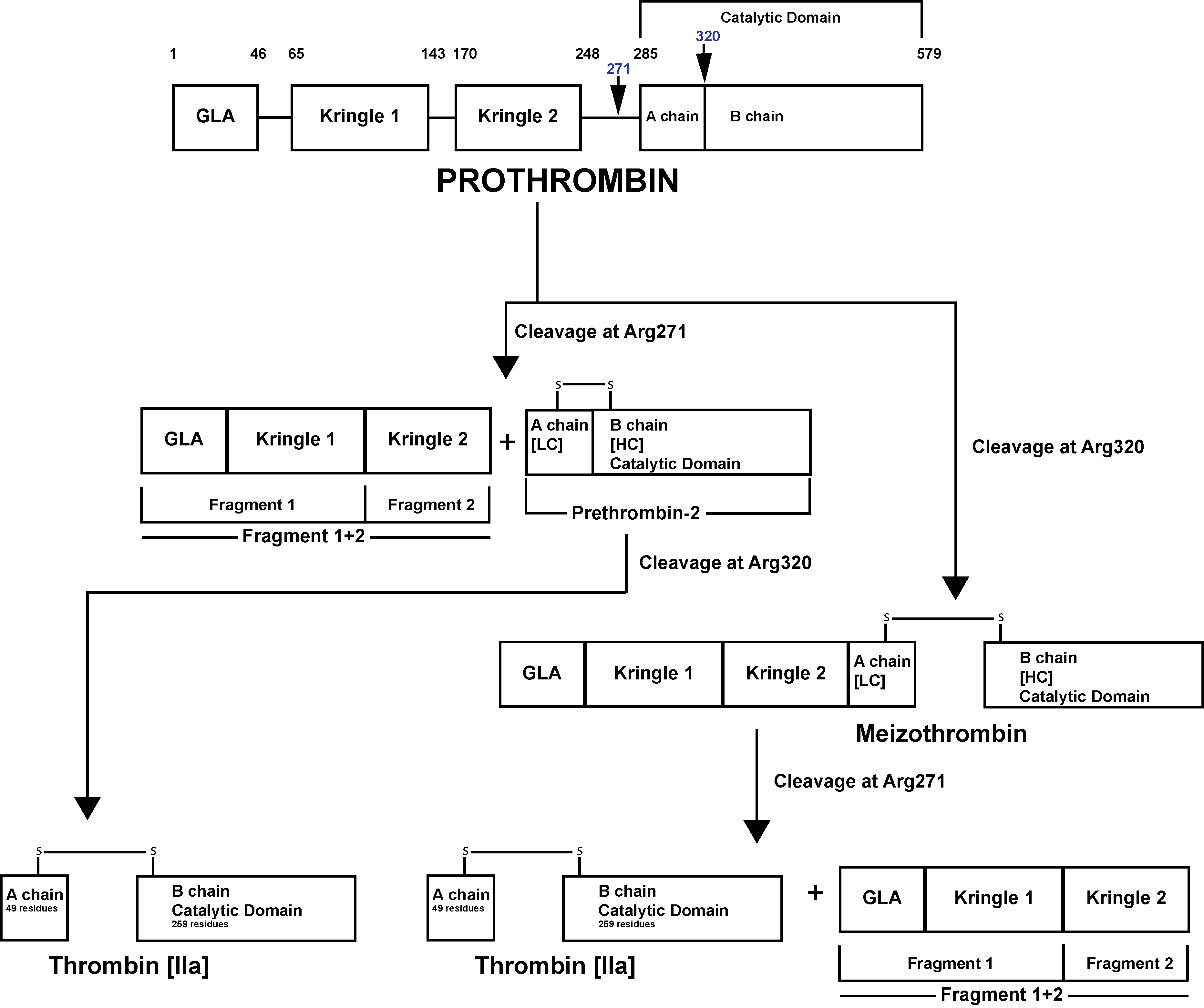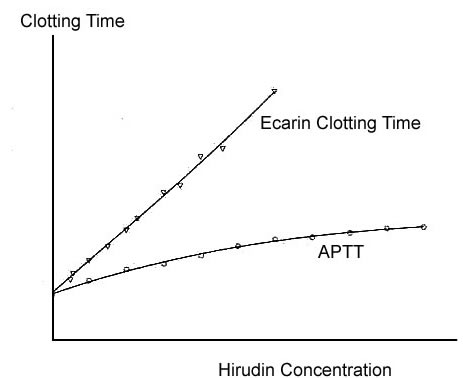[Echis Clotting Time]
Introduction
The Ecarin Clotting Time [ECT] is a Meizothrombin [mIIa] generation test that can be used to measure the activity of direct thrombin inhibitors such as Argatroban and Dabigatran. The direct thrombin inhibitor, r-Hirudin (Lepirudin), is no longer available.
Ecarin is a highly purified metalloprotease isolated from the venom of the saw-scaled viper Echis carinatus and a specific activator of Prothrombin. Prothrombin is converted in a series of steps to Thrombin and Ecarin specially cleaves Prothrombin at Arg320-Ile321 to generate Meizothrombin, an intermediate which is proteolytically active. Meizothrombin is inactivated by the direct Thrombin inhibitors but is unaffected by Heparin as the Heparin-Antithrombin complex cannot inhibit Meizothrombin due to steric hindrance.
See the image below for further information on the generation of Meizothrombin [mIIa]. Click HERE for an enlarged image.

Dabigatran-induced inhibition of Meizothrombin can be assessed by the ECT and the ECT is both linearly and dose-dependently related to Dabigatran concentrations. Dabigatran and Argatroban can also be monitored using a Dilute Thrombin Time - see Thrombin Time. The graph below shows the results for r-Hirudin but the principles are the same for other DTIs.

The Thrombin time shows similar problems to the APTT for monitoring the Direct Thrombin Inhibitors [DTIs] and shows a non-linear dose response curve. The Quantitative Thrombin Time [QTT], however measures the time to clot formation in a 1:10 diluted patient plasma sample after incubation with fibrinogen and with clotting induced by Thrombin. The QTT appears insensitive to Heparin, Lupus Anticoagulants, low Fibrinogen, clotting factor concentration and elevated FDPs and appears to be suitable for monitoring the DTIs.
Principles
The conventional ECT involves the addition of small amounts to Ecarin to plasma and measuring the time to clot formation i.e. the conversion of Fibrinogen to Fibrin. Meizothrombin is generated by the Ecarin and cleavage at the Arg320-Ile321 bond is the rate-limiting step in its formation. In the presence of DTIs, Meizothrombin is inhibited and so clot formation is prolonged.
The ECT is insensitive to Heparin as Heparin bound to Antithrombin forms a complex and due to steric hindrance, it cannot interact with Meizothrombin.
Method
1. The Ecarin Clotting Time [ECT]
i. Citrated Plasma is diluted with an equal volume of Tris buffer.
ii. Measurement of the clotting time starts with the addition of an Ecarin solution with a final concentration of 5 Ecarin units/ml. The proteolytic activity of non-inhibited Meizothrombin is quantified by measuring the conversion of Fibrinogen to Fibrin.
iii. A reference calibration curve is constructed using serial dilutions of a normal plasma pool to which has been added the Direct Thrombin Inhibitor at various concentrations.
The ECT relies on both the Prothrombin and Fibrinogen in the the patient’s sample and in some clinical settings in which these are abnormal, this can cause problems.
2. Chromogenic Assay: The Ecarin Chromogenic Assay [ECA] is similar to the Ecarin Clotting Time but the Ecarin solution contains human Prothrombin and the generation of Meizothrombin [and its subsequent inhibition by direct Thrombin inhibitors] is measured using a specific chromogenic substrate. This assay is independent of any variability in Fibrinogen and Prothrombin levels and is not influenced by Heparin or vitamin K antagonists such as Warfarin.
Reference Ranges
The
reference range for the Ecarin Clotting Time is 22.6-29 seconds.
Interpretation of a Prolonged Ecarin Clotting Time [ECT]
The ECT will be prolonged in the presence of Direct Thrombin Inhibitors such as Argatroban and Hirudin. The test will also be abnormal if Prothrombin levels are reduced such as in inherited Prothrombin deficiencies and if the Fibrinogen levels are reduced as in a hypo- or hypo-dysfibrinogenaemia.
Ecarin can activate both Prothrombin and des-carboxy-Prothrombin [PIVKA = Protein Induced by Vitamin K Absence] - that is the acarboxylated form of Prothrombin that is present in cases of Vitamin K deficiency or in individuals taking a vitamin K antagonist such as Warfarin [although the Prothrombin Time will be prolonged] and in liver disease. However, the Ecarin Chromogenic Assay [ECA] is unaffected by Fibrinogen and Prothrombin levels and is not influenced by Heparin or vitamin K antagonists such as Warfarin.
